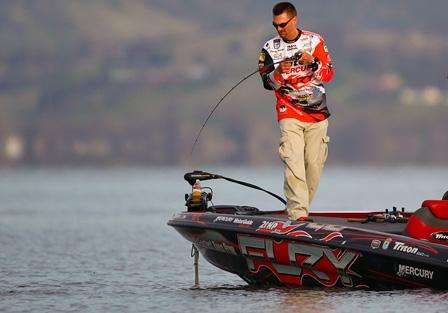
Randy Howell is one of the finest and most consistent anglers in the Bassmaster Elite Series. He's finished in the Top 10 of the Toyota Tundra Bassmaster Angler of the Year rankings four times and is headed for his 10th Classic in 2012. When Howell talks bass fishing everyone should listen, and when fall rolls around he reaches for a shallow-running crankbait.
Seasons
Fall
Water Conditions
Water temperature: Mid 60s.
Water color: Stained is best. If the water's too clear, the fish can be spooky. Howell will search out stained water for this pattern.
Wind/current: Wind is your friend — especially in the fall. Howell likes windblown banks and pockets and says wind helps to cut unwanted visibility in clear water.
Structure/Cover
Structure: Flats and pockets that hold schools of shad. Shad can seemingly be everywhere, so you won't always find bass with them, but wherever you find bass, you're almost certainly going find baitfish.
Cover: Don't worry about cover. The bass will be there if the shad are there, but if you see a stickup or other cover, definitely give it a cast. And be sure to run your bait through the dark spots — those are shad schools.
Depth: 0-5 feet, though 2-3 feet is best.
Tackle
Lure: Molix Sculpo SS crankbait in Purple Albino Shad or Mx Shiner.
Rod: 7-foot medium action Team Daiwa Zillion casting rod.
Reel: Team Daiwa Zillion Type R casting reel with a 7.3:1 gear ratio.
Line: Molix 15-pound-test fluorocarbon.
Presentation
Cast/Flip/Pitch: Long casts to cover lots of water. Fan cast the area without moving the boat a great deal. Bass are likely to be cruising and following the shad rather than relating to cover. They could be almost anywhere.
Retrieve: In a word, "fast." You're looking for a reaction strike and trying to cover a lot of water. Howell retrieves his crankbait fast and steady most of the time, but if that's not working, he'll change things up and give it a more erratic cadence.
Keys to Success
Howell says fall fishing can be tough and unpredictable at times. As good as this pattern has been to him, it's stronger in the afternoon than in the morning, and it can be important to make multiple stops on the best-looking areas. You never know when the bass might "wake up" and start feeding. Howell also notes that when you're fishing into the back of a pocket you can sometimes stir up some mud or shake up a school of shad that will lead to better fishing once you turn the boat around and start fishing your way back out.





